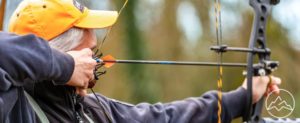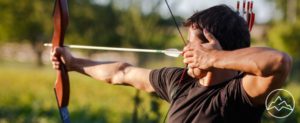In the world of archery, selecting the ideal wood for crafting a bow is a crucial decision that can greatly impact an archer’s performance. With a wide array of wood options available, understanding the unique characteristics and advantages of each type is essential. From hickory and red oak to elm and basswood, each wood offers its own set of qualities that can enhance the bow’s strength, flexion, and overall performance. Additionally, woods like maple, eastern redcedar, and osage orange bring specific benefits such as strength, lightness, and compression resistance. Bamboo, on the other hand, serves as a versatile backing option. It is important to consider individual shooting style and desired bow characteristics when choosing the right wood. Whether through reputable online websites or local retailers, finding the perfect bow wood is made easier by joining an archery community that can provide valuable guidance and resources. In this ultimate guide, we will delve into the various types of archery bow wood, their characteristics, advantages, and how to make an informed choice.
Key Takeaways
- There are many options available for archery bow wood, each with its own advantages and disadvantages.
- Different woods are suitable for different types of bows, such as self bows, laminated longbows, and wooden recurve bows.
- Factors to consider when choosing bow wood include strength, flexibility, weight, and compatibility with shooting style.
- It is important to choose high-quality wood from reputable sources and consider backing the bow to minimize damage.
Types of Archery Bow Wood
There are various options available for archery bow wood, each with its own advantages and disadvantages, including hickory, red oak, dogwood, elm, basswood, maple, eastern redcedar, osage orange, bamboo, white oak, black locust, ipe, yucca, lemonwood, yew, wych elm, hawthorn, and laburnum. Traditional bow woods such as hickory, red oak, and elm have been used for centuries and offer a classic feel and look. However, modern materials like bamboo and ipe have gained popularity due to their superior strength and flexibility. Proper care and maintenance are essential for preserving the longevity of bow wood. This includes storing the bow in a cool, dry place and periodically applying a protective coating. Regular inspections for any signs of damage or wear are also recommended to ensure optimal performance.
Characteristics and Advantages
Characteristics and advantages of different wood types for archery bows vary widely, with options like hickory, red oak, dogwood, elm, basswood, maple, eastern redcedar, osage orange, bamboo, white oak, black locust, ipe, yucca, lemonwood, yew, wych elm, hawthorn, and laburnum offering a range of strengths, flexibility, density, and suitability for specific bow designs.
- Choosing the best wood for a traditional longbow: Traditional longbows require woods that provide both strength and flexibility. Yew is a popular choice due to its lightweight nature and excellent performance. Hickory, maple, and ash are also commonly used for their strength and durability.
- The advantages of laminated bow woods: Laminated bow woods, such as yew, hickory, maple, ash, purpleheart, greenheart, satinwood, lemonwood, and osage, offer enhanced structural integrity and performance. The combination of different woods in a laminate bow creates a stronger and more reliable bow. Laminated bows are less prone to warping and can handle higher draw weights.
When choosing the best wood for an archery bow, it is important to consider the specific requirements of the bow design and the desired shooting style. Consulting with experienced bow makers or archery professionals can provide valuable guidance in selecting the most suitable wood for optimal performance.
Choosing the Right Wood
The selection of an appropriate wood type for an archery bow is crucial to ensure optimal performance and durability. There are several factors to consider when choosing bow wood. Firstly, the intended use of the bow should be taken into account. Different wood types have varying characteristics that make them suitable for specific purposes. Additionally, the archer’s shooting style and skill level should be considered. Some woods offer more forgiveness and are easier to shoot, while others may provide more power and speed. It is important to select a wood that matches the archer’s abilities and preferences. Furthermore, the availability and cost of the wood should be considered. Some wood types may be more readily available and affordable than others. Finally, it is recommended to seek advice from experienced archers or consult reputable sources to gain insights and tips for selecting the best wood for your archery bow.
Frequently Asked Questions
How can I prevent my wooden bow from warping or cracking over time?
To prevent a wooden bow from warping or cracking over time, there are several measures that can be taken. First, it is important to properly season the wood before bow making, ensuring that the moisture content is reduced to prevent warping. Additionally, applying a protective finish or coating to the bow can help minimize moisture absorption and subsequent warping. Alternatives to wood for making bows include materials such as fiberglass, carbon fiber, and laminates, which offer increased durability and resistance to warping.
Are there any specific types of wood that are best suited for traditional longbows versus modern recurve bows?
The best wood choices for traditional longbows include yew, hickory, maple, ash, purpleheart, greenheart, satinwood, lemonwood, and osage. Each wood type has its own unique characteristics that can enhance the performance of a longbow. However, it is important to consider the pros and cons of using wood versus other materials for making a bow. Wood offers a traditional and natural feel, but it may require more maintenance and can be affected by changes in temperature and humidity. Additionally, wood may not provide the same level of strength and durability as modern materials like fiberglass or carbon fiber.
Can I use any type of wood to make a laminated bow, or are there certain woods that work better for this construction method?
When making a laminated bow, not all types of wood are suitable for this construction method. Some woods work better than others, offering distinct advantages and disadvantages. For example, yew, hickory, maple, ash, purpleheart, greenheart, satinwood, lemonwood, and osage are commonly used for laminated longbows. Each wood type has its own unique characteristics that can affect the performance and durability of the bow. Therefore, choosing the right wood is crucial for ensuring a high-quality laminated bow.
What are some common mistakes to avoid when selecting and working with bow wood?
When selecting bow wood, it is important to avoid common mistakes to ensure optimal performance. One common mistake is choosing a wood that does not match the archer’s shooting style. It is crucial to consider the characteristics of each wood type and how they align with the desired bow design. Additionally, inadequate attention to tension and temperature can result in a bow that is too stiff or too flexible. When working with bow wood, it is essential to follow proper techniques and guidelines to prevent damage and ensure a successful outcome.
Are there any alternative materials to wood that can be used to make a bow?
While wood is the traditional material for making bows, there are alternative materials that can be used. These include fiberglass, carbon fiber, and laminates such as Dacron or Kevlar. The advantage of using non-wood materials is that they offer increased strength, durability, and consistency compared to natural wood. However, they can be more expensive and lack the traditional aesthetic appeal of wooden bows. Additionally, non-wood materials may require specialized equipment and skills for construction and maintenance.
Conclusion
In conclusion, selecting the ideal bow wood is vital for archers crafting their own bows. Various options, such as hickory, red oak, and maple, offer distinct advantages and characteristics. Osage orange stands out as the unrivaled “King of Bow Woods” due to its exceptional compression strength. Bamboo serves as an affordable backing option, while other woods like yew and wych elm possess unique qualities. It is crucial to consider shooting style and desired bow attributes when making a decision. Reputable online platforms and archery communities are valuable resources for purchasing and guidance.












